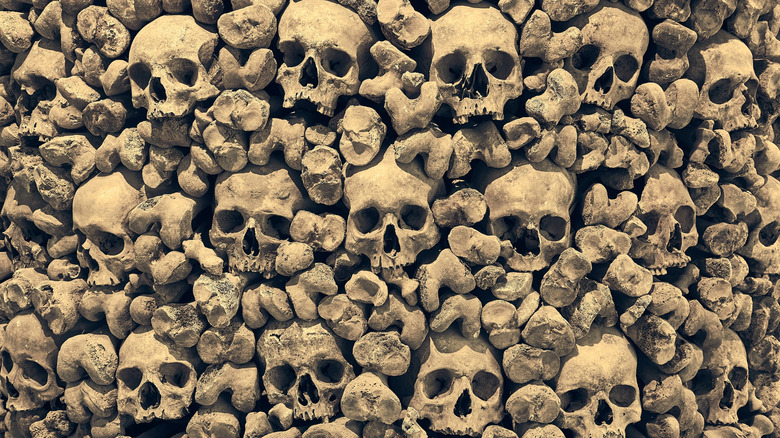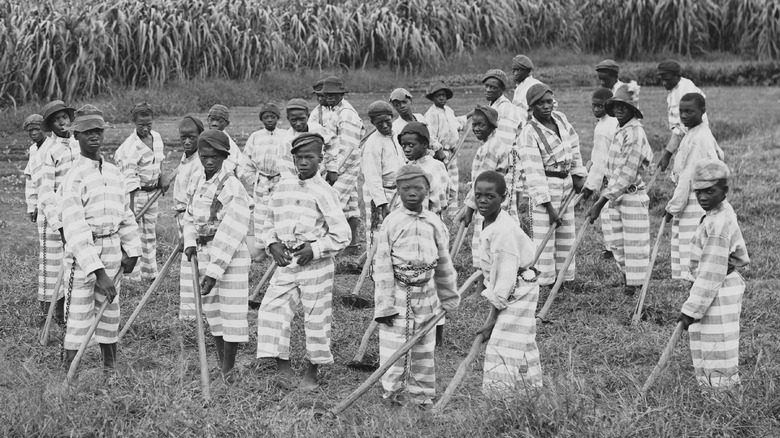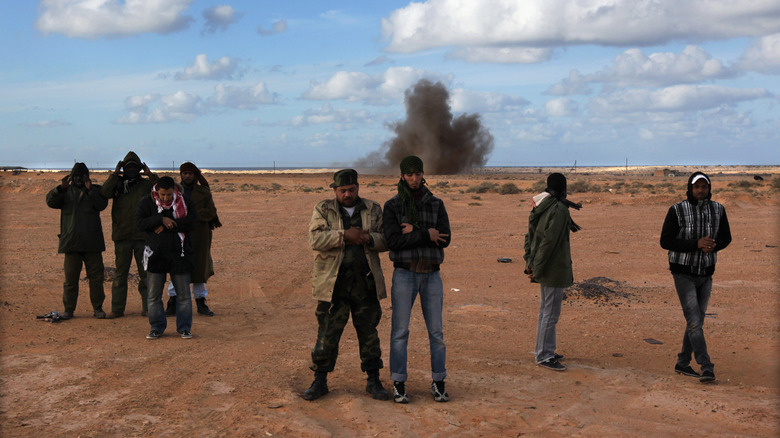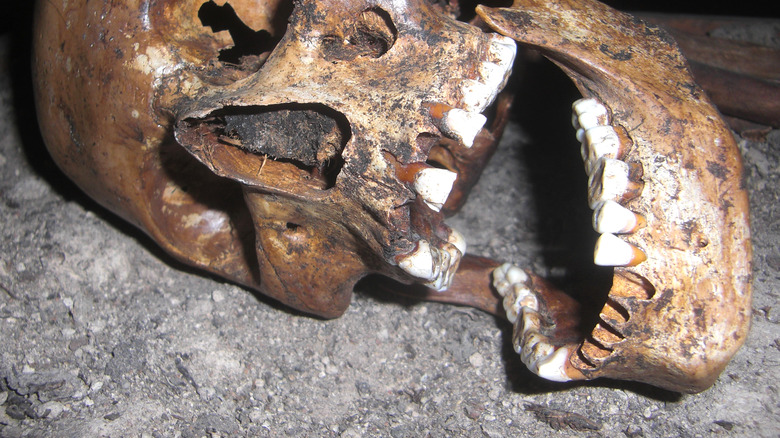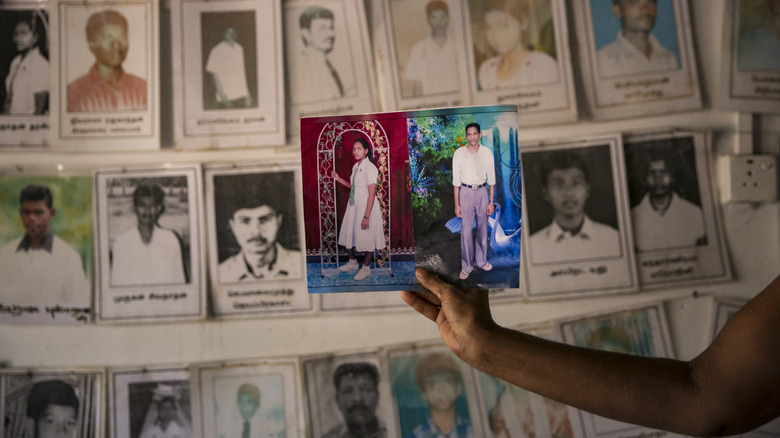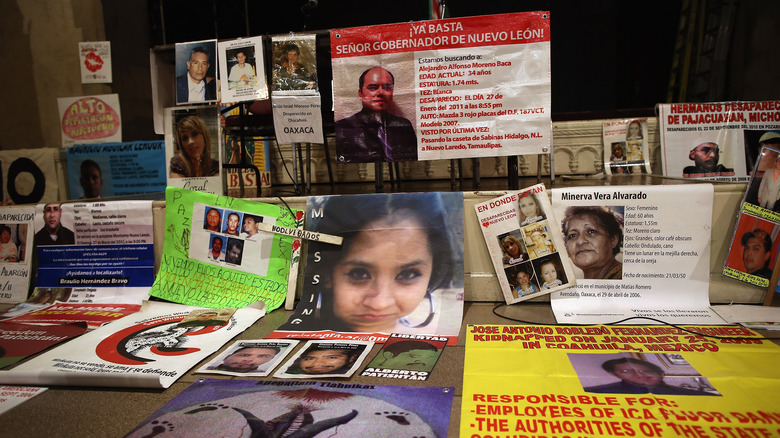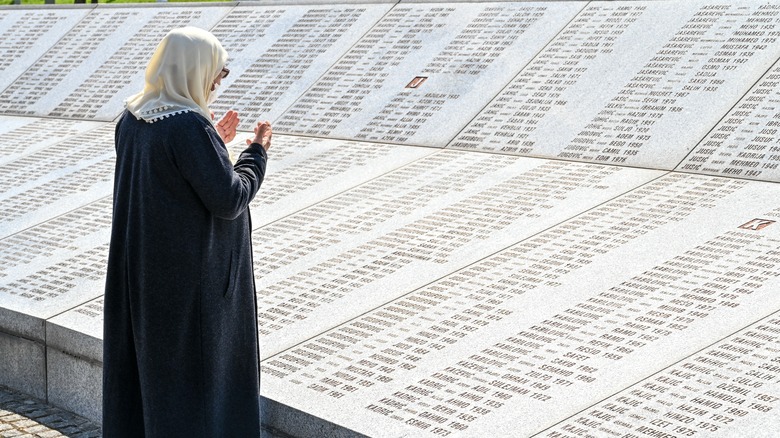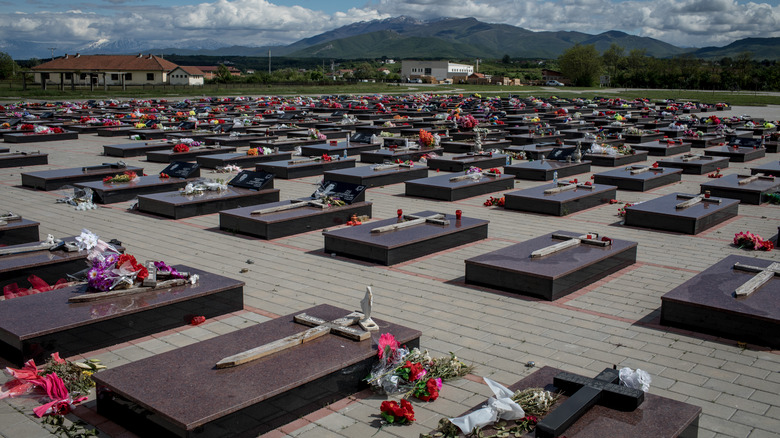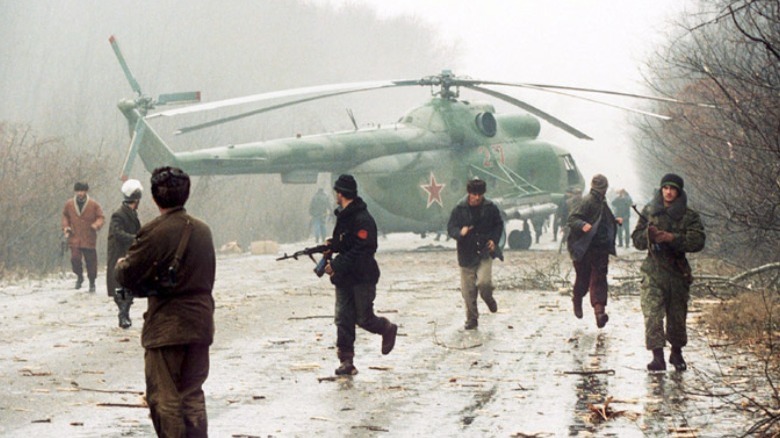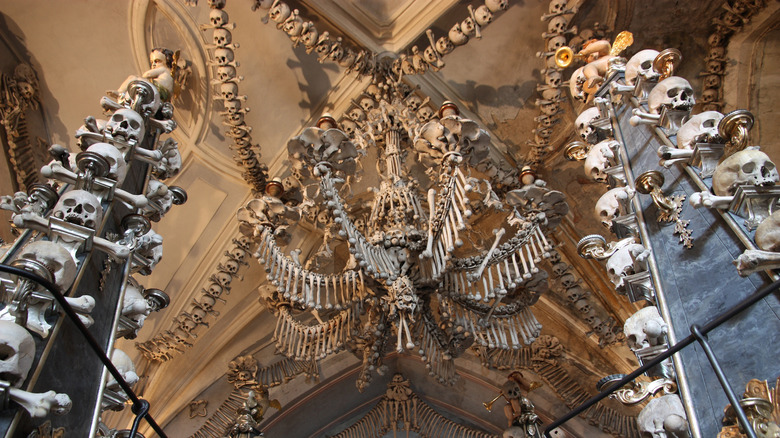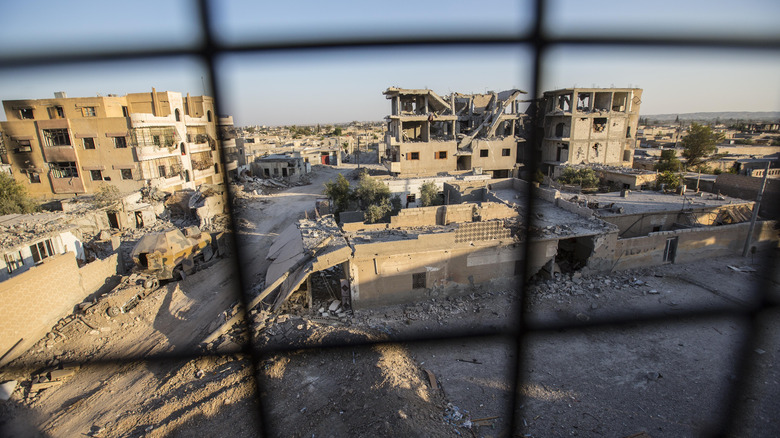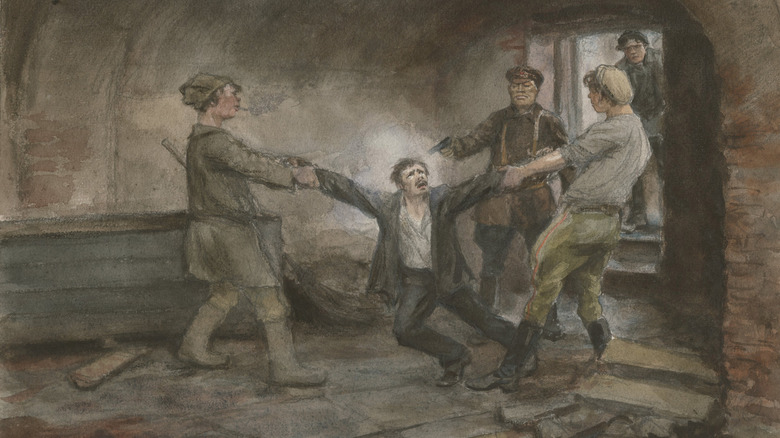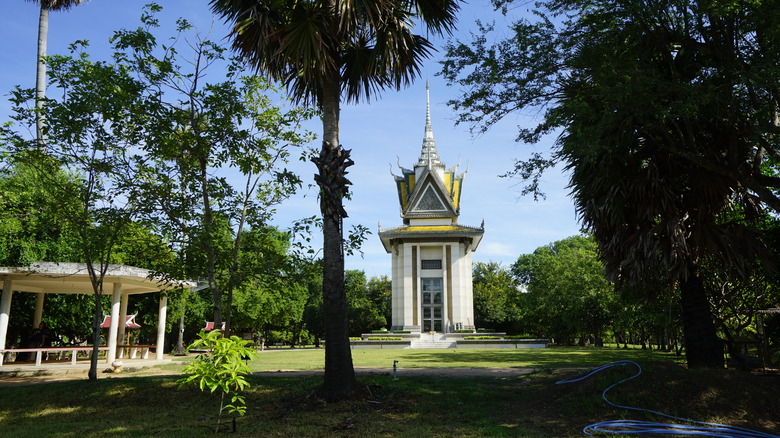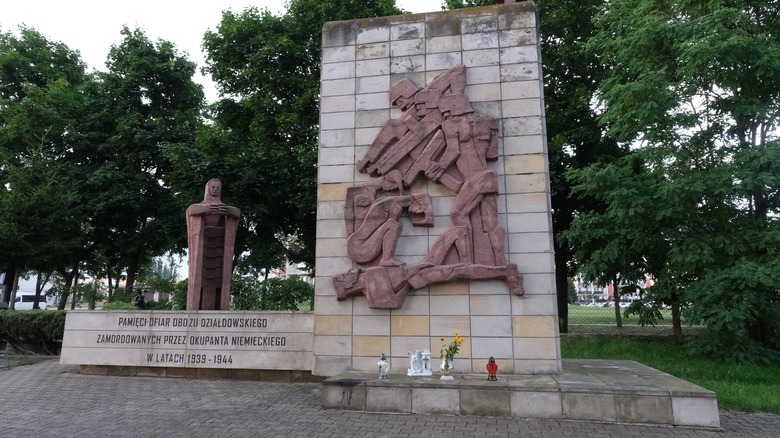The Largest Mass Graves Ever Discovered
Mass graves have been around for almost the entirety of human history, but the earliest definition of a mass grave was created as recently as 1987. According to "Human Remains and Identification," Arthur Keith Mant defined a mass grave as a grave "where two or more bodies in physical contact are buried together" after working on excavations of graves related to the Nuremberg trials. Meanwhile, M. Skinner defined a mass grave as having at least six bodies and for them to be placed randomly and tightly together "with no reverence to the individual."
Others have moved away from the idea of quantity and have instead focused on whether or not those buried in a mass grave share a common trail. And some, like former UN Special Rapporteur Bacre Waly Ndiaye, have underlined the association of extrajudicial or arbitrary executions.
Although hundreds of mass graves are known, not all of them have actually been excavated. Some mass graves, like the one at Babyn Yar, were covered up before the bodies had a chance to be exhumed. But every year, mass graves continue to be found, and more often than not, they are associated with violent conflicts old and new. These are some of the largest mass graves ever discovered.
Working imprisoned people to death
In February 2018, the remains of 95 people were found in Sugar Land, Texas, on a site where the Texas school district was building a new technical center. And during the following July, CNN reports that the bodies were identified to be those of freed Black people who had been imprisoned and forced to work in convict labor camps. The Black people buried there were estimated to be between the ages of 14 and 70.
The Washington Post reports that the site used to be home to the former Imperial State Prison Farm and describes the area now known as Sugar Land as a "notorious network of sugar cane plantations and prison camps." According to Smithsonian Magazine, the area was known as the "Hellhole on the Brazo." Through the system of convict leasing, the state leased out imprisoned people to private contractors after the Civil War, overwhelmingly targeting Black people in doing so. In Texas alone, over 3,500 people died while imprisoned between 1866 and 1912. Many of these deaths are attributed to convict leasing, and as a result, Texas outlawed the practice as a result in 1912.
According to The Conversation, construction continued during the excavation and the city of Sugar Land "quickly decided that the exhumed bodies would be reburied elsewhere."
Rebel fighters in Libya
In December 2011, a mass grave was found in Bin Jawad, Libya, that contained the remains of at least 170 people who'd been killed during the Battle of Bin Jawad during the revolution in 2011. The bodies belonged to rebel fighters who fought against the government forces of Colonel Muammar Gaddafi and, according to "Libya: From Repression to Revolution," edited by M. Cherif Bassiouni, the causes of death among most of the bodies were shelling and gunshot wounds.
According to Gulf News, this is the largest mass grave discovered in Libya associated with the First Libyan Civil War, which lasted from February to October 2011 and ended with Gaddafi's capture and execution. Libya Herald writes that there was intense fighting in Bin Jawad during the civil war, with 60 people confirmed dead and another 700 people declared missing.
By March 2012, up to 80 of the bodies had been identified, the youngest of whom was a 17-year-old boy. According to Omar Al Obaidi, head of the government-run missing persons office, "These are civilians who were protesting in their cities and [were] killed by Gaddafi's men."
A Neolithic massacre
In 1983, archeologists started excavating a site in Schletz, Austria. There, they proceeded to find over the years the remains of approximately 200 people. "The bodies were deposited [lying flat and face down] and many skeletons were incomplete with extremities missing," according to Radiocarbon.
Live Science writes that the skeletal remains date back to the early Neolithic period, roughly 5600 B.C. and 4900 B.C. And at least 67 skeletal remains of different people that have been investigated by osteologists showed lethal skull fractures.
The mass grave is associated with the end of the Linearbandkeramik culture (LBK) and isn't the only mass grave to be associated with the LBK. At least three different mass graves have been found in the region that date back to the end of the LBK. As a result, it's believed that this was an especially violent period, especially due to the archeological evidence of settlements with fortifications.
Aftermaths of a civil war
In Mannar, Sri Lanka, a mass grave with up to 230 bodies was found in August 2018. The bodies were found in an area that was a former war zone during the Sri Lankan Civil War, which lasted from 1983 to 2009, according to the BBC. This mass grave is, as of 2022, the largest mass grave to ever be found in Sri Lanka. And unfortunately, Asia News writes that it's difficult to identify the bodies due to the decomposition as well as the fact that "the bones are scattered and it is difficult to understand the height of the bodies. Also some bones are missing. It is a total chaos."
The Sri Lankan Civil War was fought between the Sinhalese-dominated Sri Lankan government and the Liberation Tigers of Tamil Eelam, also known as the Tamil Tiger rebels, who, according to Harvard International Review, wanted to create a separate state for Tamil people, who are a minority in Sri Lanka. The mass grave was found in an area that is majority Tamil and was occupied by the military during the civil war. It's also known for being "one of the bloodiest theaters of the battles" during the civil war.
At least 100,000 people died during the 26-year-long civil war, and at least 20,000 people were disappeared or declared missing. Independent reports that in 2020, Sri Lanka's president Gotabaya Rajapaksa acknowledged for the first time that the 20,000 disappeared people were dead.
Casualties of Mexico's drug war
Over 250 skulls and skeletal remains were found in a mass grave outside of Veracruz, Mexico, in March 2017. According to The Guardian, the remains belonged to people who were disappeared and killed by the drug cartels in previous years. In 2011, at least 250 bodies were also found in mass graves in San Fernando, Mexico, which were also attributed to the drug wars.
The New York Times reports that the mass grave was first found by members of Colectivo Solecito, a group of women with missing children. In 2016, members of the collective were given a map with locations of graves on it by cartel members during a street protest. "Among the remains recovered in the last six months and already identified were the bodies of a former state prosecutor and his secretary, who were kidnapped by police officers working for a drug gang in 2013."
In 2021, Ioan Grillo wrote in "Blood Gun Money" that the mass grave found in 2017 was "to date, the largest mass grave discovered in the Mexican Drug War." However, this was rivaled in July 2022 when another mass grave was found in an abandoned water park at the Los Negritos natural reserve in Michoacán. According to VICE, it's estimated that there could be as many as 500 bodies in the mass grave.
Mass graves of genocide
Eight years after the Bosnian War ended, a mass grave was discovered in the village of Snagovo, Bosnia and Herzegovina, in August 2003. The Guardian reports that initially 150 bodies were discovered, but by the end of the excavation, the remains of 629 people had been found. The bodies belonged to Bosnian Muslim adults and children of all genders, most of whom were civilians, that were killed by Bosnian Orthodox Christian Serb soldiers between April and June 1992 during the Bosnian War. According to Bitter Land, some of the remains also belonged to Roma people as well.
The Bosnian War began after the dissolution of the Socialist Federal Republic of Yugoslavia and lasted from April 1992 to December 1995. After Bosnian people voted to declare independence, Bosnian Serb forces made moves to take over the country, starting with the Siege of Sarajevo. Between 100,000 and 250,000 people during the war, and another two million more were displaced. But the deaths were largely due to a systematic extermination known as the Bosnian genocide, where 80% of those killed were Bosnian Muslims.
Remembering Srebrenica writes that during the final years of the war, there was an organized and comprehensive effort among the Bosnian Serb Forces to hide the evidence of massacres "by digging up and reburying, in isolated locations, bodies exhumed from mass graves." There are even gravesites near the Crni Vrh mass grave that are connected with the Srebrenica massacre as a result.
Targeting civilians in Kosovo
In May 2001, a mass grave was discovered 12 miles away from Belgrade, Serbia, less than a year after the overthrow of President Slobodan Milosevic of Yugoslavia. Bitter Land writes that the remains of 744 people were found, and all of them belong to Kosovo Albanians, the majority of whom are Muslim, who were murdered in the spring of 1999 by the Orthodox Christian Yugoslav Army, Serbian police, and paramilitaries during the Kosovo War.
The Kosovo War started in February 1998 and lasted until June 1999, with the Kosovo Liberation Army, made up of Kosovo Albanians, fighting against Serbian forces led by Milosevic. Enika Abazi writes in A New Power Play in the Balkans that although Kosovo first declared independence in 1991, the Yugoslav government responded with a wave of oppression that eventually led to the Kosovo War. Al Jazeera reports that approximately 13,000 people were killed during the Kosovo War, many of whom were Kosovo Albanians.
According to Humanitarian Law Center, the bodies found at Batajnica belonged to adults and children of all genders, most of whom were civilians, and for many, the cause of death was a gunshot wound to the head, "suggesting that the victims did not die in combat but as a result of execution-style killings outside situations of combat." Some of the bodies were also reportedly moved between April and June 1999 in an attempt to hide the evidence of the massacre.
Civilian casualties
A mass grave filled with up to 800 bodies was discovered in Grozny, Chechnya, Russia, in June 2008. According to The New York Times, this wasn't the first mass grave to be found in Chechnya. At the time, 57 other mass graves had been identified, and it's not considered unusual for "construction crews in Grozny to run across collections of bodies."
The bodies are believed to have been buried in the mass grave between January and October 1995, meaning that the mass grave was filled during the First Chechen War. Most of the bodies belong to civilians, and as of 2022, this is the largest mass grave to be uncovered in Grozny, according to the "Historical Dictionary of the Chechen Conflict" by Ali Askerov.
The First Chechen War was fought from December 1994 to August 1996 between the Chechen Republic of Ichkeria against the Russian Federation. After Chechnya declared independence from the Soviet Union in November 1991, President of the Russian Soviet Federated Socialist Republic Boris Yeltsin declared a state of emergency in Chechnya and sent 1,000 troops to Grozny, although these troops were promptly forced to withdraw. But Small Wars Journal writes that three years later, Yeltsin tried once more to regain the Chechen territory as Russian troops invaded Chechnya in December 1994, starting the First Chechen War.
A medieval mass grave
One of the largest mass graves ever discovered in Europe dates all the way back to the 14 century. Discovered in November 2017 in Kutna Hora, Czech Republic, the mass grave contained over 1,500 skeletons that are believed to have belonged to people who died of starvation from famine in 1318 and a plague epidemic that started in 1348 in Bohemia, according to Archeology.
Newsweek writes that such a large mass grave, which is technically a collection of 30 mass graves, is incredibly useful to archeologists. Jan Frolik, the Czech archeologist leading the research into the mass graves, stated that "We must realize that such a mass grave represents a sample of a population within a very short period, which is extremely valuable to us. The 30 graves, as far as I know, are the largest set in Europe."
The mass grave was found at the site of the Sedlec Ossuary, also known as the bone church, which is decorated with over 40,000 human skeletons, per Atlas Obscura.
Caught in the crossfire
In the suburb of Al-Fukheikha outside of Raqqa, Syria, a mass grave was discovered in February 2019. And according to ANF News, this mass grave was the largest mass grave discovered in Syria ever since reconstruction began in Raqqa after IS was pushed out in 2017.
It was estimated that the mass grave contained the remains of 2,500 to 3,000 people, in addition to roughly 900 to 1,100 people in individual graves, bringing the total to at least 3,500 people buried in the mass grave at Raqqa. Al Jazeera reports that the causes of death ranged from being stoned to death and shackled and executed with a gunshot to the head. And the victims are believed to be people executed by IS fighters, people killed in coalition air strikes, or people who have been missing for years.
During the Syrian Civil War, which began in March 2011 and is ongoing as of August 2022, ISIL took Raqqa and ruled with it as its de facto capital for four years. Amnesty International writes that during this time, IS was documented perpetrating numerous crimes against humanity, including using civilians as human shields. Meanwhile, the US-led coalition is also believed to be responsible for killing over 1,600 civilians.
Swallowed up in the Great Purge
In August 2021, researchers discovered what has been described as one of Ukraine's largest Stalin-era mass graves. According to the BBC, during exploration work for an expansion of an airport in Odesa, Ukraine, at least 29 graves were discovered that are believed to contain the bones of between 5,000 and 8,000 people. France24 writes that the mass grave may even contain as many as 20,000 people
Smithsonian Magazine writes that the graves are thought to date back to the 1930s, when Premier of the Soviet Union Joseph Stalin unleashed a campaign of terror against political dissidents and civilians known as the Great Purge.
During the Great Purge, the NKVD – the Soviet secret police predecessor to the KGB – executed hundreds of thousands of people while millions more were imprisoned in the Gulag. And in Odessa, over 8,500 people were sentenced to death by the NKVD just between 1938 and 1941 alone.
Unfortunately, with the Russian invasion of Ukraine in February 2022, excavation on the site likely ceased and has yet to resume as of July 2022. But Ukraine isn't the only former Soviet country with Soviet-era mass graves. In Georgia, a mass grave with the remains of 150 people was found in Khelvachauri in 2019, writes the Institute for Development of Freedom of Information.
The killing fields
The killing fields of Choeung Ek in Cambodia were originally a Chinese graveyard. But according to Interactions with a Violent Past, from 1977 to the end of 1978, they were used as a killing site and mass grave for thousands of people who were executed during the purges of Pol Pot, the Prime Minister of Cambodia during the Khmer Rouge. The bones and skulls were exhumed during the early 1980s, and The Phnom Penh Post reports that the remains of at least 6,426 people were found. And "only one skull was discovered without indications of torture or heavy beating."
During their regime, which lasted from 1975 to 1979, the Khmer Rouge perpetrated the Cambodian Genocide, which resulted in the deaths of between 1.5 to 3 million people. According to Mass Atrocity Endings, thousands of people were targeted for elimination, including Buddhists, minorities, and any Cambodian person who was considered a dissident. While some of the people died due to torture and beatings from the Khmer Rouge, others "died beforehand because the regime used the pesticide DDT to spray gravesites." Some are also believed to have died as a result of medical experiments.
After their exhumation, the remains were put on display at Choeung Ek inside a glass exhibition cabinet, Susan E. Cook writes in "Genocide in Cambodia and Rwanda."
A grave of ashes
In July 2022, a mass grave that contained the human ashes equivalent to the remains of 8,000 people was found in Dzialdowo, Poland. According to Al Jazeera, the mass grave was found near the former Soldau concentration camp, which was operated by the Nazis during their occupation of Poland during the Second World War. Live Science writes that so many people were killed by the Nazis in some areas of Poland that places like Pomerania were known as Death Valley.
The BBC reports that the mass grave contained 17.5 tons of human ashes and is believed to belong to people executed by the Nazis who were then exhumed and burned by the Nazis in an attempt to hide the evidence of their massacres.
It's estimated that up to 30,000 people were murdered at the Soldau concentration camp, including Jewish people, political opponents of the Nazis, and members of the Polish elite. Archeologists also found traces of clothing and buttons, "but nothing of value, indicating the bodies were robbed before being set alight."
